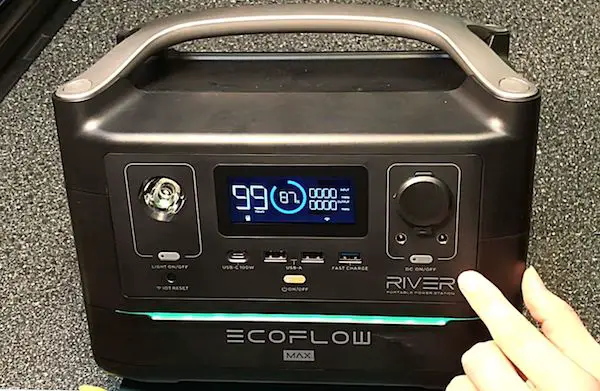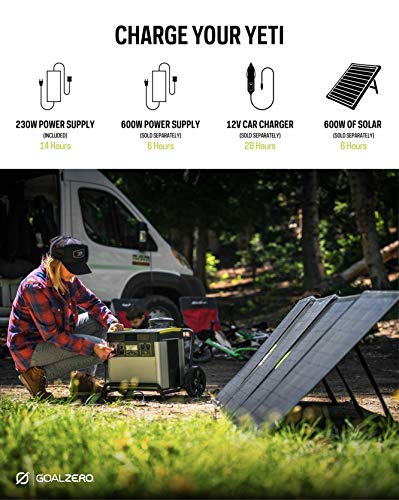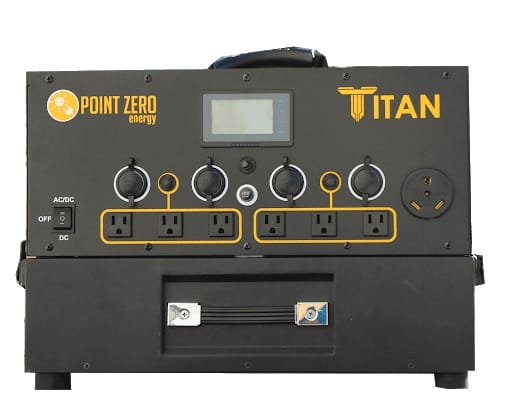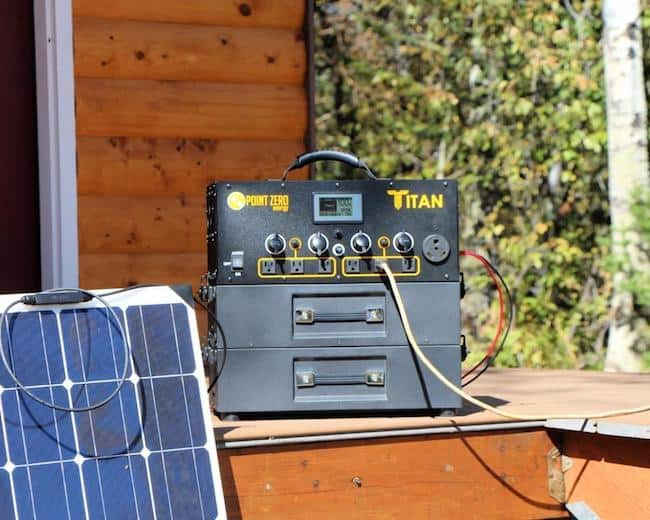Using a solar generator to power your well pump is possible with the proper sizing and calculations.
Below, I clarify what information is necessary for you to determine if any type of solar generator is capable of powering your well pump.
Here’s the layout of this guide:
Can a Solar Generator Power a Well Pump?
A solar generator can power a well pump. However, some well pumps require much more power than others. The daily power consumption of the well pump will help you correlate it to the ideal solar generator needed to run your pump daily.
The main factors you need to know in order to pair a solar generator to your well pump are:
- How much power is needed in watts (W) when the pump is on and running? This is found by multiplying volts (V) times amps (A). Knowing your well pump’s power requirements (starting surge and running watts) is essential to find out how big your solar generator needs to be.
- How many total watt-hours (Wh) are used by the pump in a 24-hour period on average?
With this information, you can find the solar generator that will meet the specifications of your well pump.
To give you a better idea of which types of pumps can be used with a solar generator, I gathered four different well pumps and broke down each one’s power requirements in terms of volts and amps.
Keep in mind that the solar generators I’ll be discussing in this post are only compatible with either 12V/10A or 115-120V well pumps. Sizing a generator for 240V well pumps is possible with a solar generator, but only a select number of models are available with 240V capabilities. One example is the Nature’s Generator Powerhouse.
is possible with a solar generator, but only a select number of models are available with 240V capabilities. One example is the Nature’s Generator Powerhouse.
4 Water Pump Examples with Power Requirements
| Water Pump | ECO-WORTHY DC 12V | Acquaer 1 HP | Little Giant 1/2 HP | Wayne 3/4 HP |
|---|---|---|---|---|
| Image | ||||
| Model # | N/A | SJC100-1 | WE20G05P4-21 | CWS75 |
| Voltage | 12V DC | 115/230V AC | 115V AC | 120/240V AC |
| Gallons/Min | 3.2 GPM | 20 GPM | 20 GPM | 7.7 GPM |
| PSI | 130-150 PSI | 30-50 PSI | 48 PSI max | 30-50 PSI |
| Amperage | 10A max | 9.6A/4.8A | 10.5A max | 13A |
| Type | Deep Well/ Submersible | Shallow Well, Jet | Deep Well/ Submersible | Convertible, Jet |
| More Info | View on Amazon | View on Amazon | View on Amazon | View on Amazon |
The table above shows not only the amps and volts, but the gallons per minute (GPM) and pressure (PSI) needed for each pump. Another important specification is the horsepower rating because even a 1/4 HP difference can significantly affect your pump’s power consumption requirements.
The GPM and PSI will be discussed later on, but the next segment has to do with the amount of power used per day for each well pump example.
This measurement will give you an idea of how large of a solar generator you need in terms of battery size.
Solar generator batteries are measured in watt-hours (Wh) and I’ve calculated the watt-hours needed each day for the well pumps below.
The “daily run times” mentioned correlate to how much water is needed for your home/cabin/etc. Typically, the more water that is used throughout the day, the longer the running time.
How Much Power Does a Well Pump Use Per Day?
A well pump’s daily power consumption varies significantly depending on the pump type, tank size, tank pressure, plumbing fixtures in your home (or desired area of use), and how often water is used throughout the day.
Below I’ve highlighted the power consumed (in watt-hours) for the four different types of well pumps mentioned previously.
I measured their consumption by half-hour increments to give you a good idea of how much power is needed depending on how often/long the well pump is running for.
Daily Well Pump Power Consumption With Run Times
| Eco-Worthy | Acquaer | Little Giant | Wayne | |
|---|---|---|---|---|
| 0.5 hrs | 60Wh | 552Wh | 604Wh | 780Wh |
| 1 hrs | 120Wh | 1,104Wh | 1,207Wh | 1,560Wh |
| 1.5 hrs | 180Wh | 1,656Wh | 1,812Wh | 2,340Wh |
| 2 hrs | 240Wh | 2,208Wh | 2,416Wh | 3,120Wh |
| 2.5 hrs | 300Wh | 2,760Wh | 3,020Wh | 3,900Wh |
As you can see, the longer the pump is running, the difference in power consumed is significant.
Well Pump Sizing
While trying to find out how often the average residential well pump runs for every day, I needed more information from an expert.
I came across a YouTube video from a company called R.C. Worst & Co., Inc. and called them for information on my question.
and called them for information on my question.
After speaking to James, an employee at the company, for a few minutes, he broke down my question into several smaller parts. The first (and most important) piece of data he mentioned was…
“You need to know how much water the home uses in gallons per minute. Next is the tank pressure and size.”
James from R.C. Worst & Co., Inc.
Both of the points he mentioned in the quote above came before any mention of the type and size of pump needed for the home.
This is an important point as there are several data points needed in order to calculate which well pump will work best for the home.
Below is a video showing the data needed to calculate the type of well pump best suited for your home/cabin.
With the above data, you should have all of the information needed to find your ideal well pump.
How Long Will a Solar Generator Run a Well Pump?
A Titan solar generator (with one battery) can run a 115V Acquaer SJC100-1 well pump (at 30 minutes of pump time per day) for approximately three days with no solar input.
With 200W of solar panels at 80% efficiency and good sunlight, the Titan is capable of running this pump continuously so long as sunlight conditions remain stable.
There are several important factors to consider when calculating the length of time that a solar generator can run a well pump, including:
- Daily well pump run times
- Power consumption of the pump
- Solar generator continuous AC inverter output, inverter efficiency, battery capacity, and battery cycle life
- Solar panel setup
Clearly, well pumps, solar generators, and well pump run times vary significantly, ultimately showing that there is a lot of math involved in getting an estimate on how long the solar generator can run a well pump for your home/cabin/etc.
To give you a better idea of how to do this for yourself, below I lay out how I calculated how long the Titan can run the Acquaer pump:
The Acquaer SJC100-1 is rated at 115V, 9.6A. Since amps (A) times volts (V) equals watts (W), I multiplied 115 by 9.6 to get 1,104W. This is its power consumption at any given time.
Next I need to find its watt-hour usage. This shows how much total energy is consumed in an hour. Simply take 1,104W times one hour to get 1,104Wh.
Running at 30 minutes per day, divide 1,104Wh by two to get 552Wh. This is the daily power consumption of the well pump.
One Titan battery is 2,000Wh. The Titan’s AC inverter, which powers the wall-styled outlets on the solar generator, runs at about 90% efficiency.
This means that the inverter uses some of the battery juice for itself while powering the well pump or other AC device plugged into it. Take 90% of 2,000Wh and you get 1,800Wh of battery left to power the well pump.
Now we can find out how long the Titan’s battery will run the Acquaer pump before running out of battery.
Take 1,800Wh divided by 552Wh equals about 3.26 days of use with the Titan. At this point the Titan’s battery is depleted.
Take 3.26 days multiplied by the Titan battery’s 2,000 charge cycles and you get 6,520 days of use before the Titan battery reaches 80% of its original capacity.
6,520 days divided by 365 days equals 17.86 years of use.
Now you can solve for your well pump if you know its daily power consumption.
Solar Generator Options for Powering Well Pumps
Below I’ve listed the top three models and will then go into more depth on each one.
I’ll then get into specific well pump examples and estimated running times with each solar generator.
| Ranking | Model | Highlights | Where to Buy |
|---|---|---|---|
| 1. Best Multipurpose | Goal Zero Yeti 3000X | – Yeti Application – 2,000W continuous AC power – 3,032Wh battery | Amazon |
| 2. Best for High-Powered Pumps | Point Zero Energy Titan | – Up to 3,000W continuous AC power – Expandable batteries – Up to 2,000W solar input (w/ 2x batteries) | Shop Solar Kits |
| 3. Best for 12V, 10A Pumps | EcoFlow River Max | – 13.6V, 10A regulated DC car port for use w/ pump – 576Wh battery | Amazon |
The Yeti 3000X is the best solar generator for well pumps because of its 3,032Wh battery, 600W solar input, and port options. Its Powerpole port can run 12V pumps rated up to 30A, and its 120V AC ports (2,000W continuous output) make it able to meet larger well pumps’ daily needs.
Depending on the power consumption of your pump, the solar generator you choose may need to be smaller or larger than the Yeti 3000X.
1. Goal Zero Yeti 3000X
| Pros | Cons |
|---|---|
| – High-powered AC ports (2,000W continuous, 3,500W surge) | – Average battery cycle life (500 cycles to 80% capacity) |
| – Large battery (3,032Wh) | – Cannot use with third-party batteries to extend battery life |
The Yeti 3000X has a battery capacity of 3,032Wh and the capacity to power equipment – such as refrigerators, lighting, power tools, well pumps, etc. – with a maximum continuous output of up to 2,000 watts from its AC ports.
Before getting into the specifics of the 3000X, in the table below I give four well pump examples of various sizes to determine how long they can run for when used with the 3000X.
Well Pump Run Times With Yeti 3000X Power Station
| Well Pump Model | Well pump usage (hrs/day) | Estimated run times: Yeti 3000X w/o solar panels | Estimated run times: Yeti 3000X w/ 600W solar input | |||
|---|---|---|---|---|---|---|
| ECO-WORTHY DC 12V Submersible Deep Well Pump | 0.5 hrs 1.0 hrs 1.5 hrs | 46 days 23 days 15 days | Unlimited days for 0.5-1.5 hrs daily pump time | |||
| Acquaer SJC100-1 1 HP Shallow Well Jet Pump | 0.5 hrs 1.0 hrs 1.5 hrs | 5 days 3 days 2 days | Unlimited days for 0.5-1.5 hrs daily pump time | |||
| Little Giant 1/2 HP WE20G05P4-21 Submersible Deep Well Pump | 0.5 hrs 1.0 hrs 1.5 hrs | 4.5 days 2 days 1.5 days | Unlimited days for 0.5-1.5 hrs daily pump time | |||
| Wayne CWS75 3/4 HP Convertible Jet Well Pump | 0.5 hrs 1.0 hrs 1.5 hrs | 4 days 2 days 1 day | Unlimited days for 0.5-1.5 hrs daily pump time |
As you can see, the 3000X can power all of the pumps mentioned in the table for an unlimited amount of days with the maximum solar input.
However, the key factor for you to consider is the run time for your well pump. I only put in data for well pumps running from 30-90 minutes per day.
The following are some additional highlights of the 3000X.
Additional Port Options
The 3000X comes with seven different output port options (ten total), enabling it to power a wide range of devices. These ports include:
- 1x USB-C PD
- 1x USB-C
- 2x Standard USB-A
- 2x 120V AC ports
- 1x 12V High Power port
- 1x 12V Car port
- 2x 6mm ports
LCD Display
The Yeti 3000X has a clear front display that enables you to monitor the energy input and output in volts, amps, and watts.
It also displays the charging status of the battery.
You can set this display to show the length of time it would take, whether in minutes or hours, for the device to become fully charged.
2,000W of AC Power
The 3000X’s AC ports have a capacity of 3,500W to start an appliance and 2,000W to keep it running. Hence, the solar generator can handle surges from several 120V sources, including well-pumps, power tools, home appliances, etc.
Remote-Controllable
The 3000X has an app, known as the Yeti App 3.0 , that allows you to monitor, control, and optimize your power usage from wherever you are via your phone/tablet.
, that allows you to monitor, control, and optimize your power usage from wherever you are via your phone/tablet.
It provides its users with notifications of power usage and charging profiles to enable you to optimize your battery life.
Multiple Charging Options
The Yeti 3000X can be charged in three different ways:
Through Direct Sunlight
You can charge this solar generator’s battery by connecting it to a compatible solar panel placed under direct sunlight. The charge time using this method is dependent on the size of the solar panel.
If you use the Boulder 200 Briefcase solar panel, which provides about 160W of power, the 3000X will become fully charged in 18 to 36 hours.
However, the 3000X can take in up to 600W of solar input, which will significantly improve charging times.
Through The Wall
You can also plug this generator into a wall outlet in your home. If you use the 230W Power Supply AC Wall Charger provided with the machine, it will become fully charged within 14 hours.
Through Your Car
Finally, the 3000X can be charged through the 12V cigarette charger in your car. This requires the Yeti Lithium 12V Car Charging Cable.
I highly recommend reading my detailed review of the 3000X. It gets REALLY in-depth on what the generator can do. I also compare it side-by-side with similar solar generators. Read it here: The Goal Zero YETI 3000X – In-Depth Review and Comparison.
For more information, check out the Yeti 3000X on Amazon here (affiliate link).
(affiliate link).
Similar: Top 5 Fastest Charging Solar Generators (Via AC Outlet & Solar Panels)
2. Point Zero Energy Titan
| Pros | Cons |
|---|---|
| – Expandable and stackable batteries (2,000Wh each) | – Only get half of maximum AC power output and solar input with one battery (need two or more) |
| – Powerful AC inverter @ 3,000W continuous, 6,000W surge (w/ two batteries) | – LCD screen doesn’t show warning indicators (need to refer to the manual if an issue occurs) |
The Titan is the ideal solar generator for well pumps that use a lot of power throughout the day.
The 3000X can run most well pumps at 115-120V, but this completely depends on the running time of the pump.
The Titan has quite a lot of features but the main ones specifically for well pumps are the following.
Expandable Batteries
Each Titan battery is 2,000Wh. This is a pretty large battery by itself, but you can attach as many additional batteries to the Titan as you want.
They can be stacked on top of each other as seen in the image above, or you can connect them side-by-side with cables.
With three batteries, you will get 6,000 total watt-hours of battery capacity, which is double that of the Yeti 3000X.
A higher battery life will give your well pump additional hours, days, or weeks of run time depending on its power consumption.
High Cycle Life

Cycle life has to do with the battery in a solar generator. The higher the cycle life, the longer the generator will last.
One charge cycle occurs when the generator’s battery goes from fully charged to depleted then back to fully charged again.
Each Titan battery is rated at 2,000 cycles to 80% capacity.
This means that you can fully use the battery and charge it up 2,000 times before the battery gets reduced to 80% of its original capacity of 2,000Wh.
This is a very long cycle life because you can cycle the battery once every day and it will last over five years before it reaches the 80% battery capacity mark, or 1,600 total watt-hours instead of its original 2,000.
With an efficient 115-120V well pump such as the Acquaer SJC100-1 (1 HP shallow well jet pump) that runs for about 30 minutes per day, a single Titan battery will last approximately 17.9 years before it hits 80% of its original battery capacity.
I break down how I calculated 17.9 years of use towards the bottom of this article.
Lots of Input & Output Power
The Titan has an AC inverter capable of up to 3,000W continuous and 6,000W of surge power. This is only achieved with two or more of its batteries attached.
With one battery, it can output exactly half (1,500W continuous, 3,000W surge).
The solar input is similarly laid out, with 2,000W max input power with two or more batteries and 1,000W max with one battery.
This is one of the highest solar inputs for any solar generator.
The only solar generator I can think of with a higher solar input is the Bluetti EP500Pro, which I wrote about in this article here: Bluetti EP500 & EP500Pro Review – Longest-Lasting Solar Generators.
My full review of the Titan solar generator goes over more internal features and specifications so you can compare and contrast it to other systems if need be.
You’ll be able to see the full capabilities of the system as well as the various port options to see if it is something you may consider for your well pump and/or other off-grid power needs.
Check it out here: Titan Solar Generator Review – The Best Large Solar Generator?
3. EcoFlow River Max

| Pros | Cons |
|---|---|
| – 200W max solar input (one of the highest compared to similar models) | – Average battery cycle life (500 cycles to 80% capacity) |
| – Regulated 12V DC car port (13.6V, 10A) | – Cannot expand battery capacity |
The River Max is a standard EcoFlow River with an additional battery attached to its base, giving you double the battery capacity of the standard model.
At 576Wh, the River Max is the smallest of the three solar generators reviewed today by far, but its purpose is not for the same style of pump as the others.
The well pump that is ideal for this model is a 12V, 10A pump. One example of this pump is the ECO-WORTHY DC 12V submersible deep well pump.
Regulated Car Port Output
You can connect the deep well pump to the car port of the River Max power station four use in your home or cabin.
The car port is regulated at 13.6V, 10A, so you can be sure that it will be able to work properly with the pump.
Since 12V, 10A pumps only consume 120W per hour of pumping time, the River Max has more than enough power and battery life to keep the pump running for hours or days depending on how often the pump is running every day.
If this system is fit for you or if you need additional information, check out the River Max on Amazon here (affiliate link).
(affiliate link).
Similar: EcoFlow vs. Jackery – Full Solar Generator Comparison (With Specs)
How Do I Choose a Solar Panel for My Battery or Solar Generator?
Choosing a solar panel is a long term investment, and it requires that you consider factors other than its pricing. The following are some of the factors you have to consider before you choose a solar panel for your battery or solar generator.
Pricing
- This is usually determined by different factors: the amount of power (in Watts), the brand or manufacturer, the physical size, the quality of materials, the durability, etc.
- Note that you shouldn’t always go for the cheapest panels or the most expensive. Choose the panels that appear to be most suitable for your needs.
Quality
- This factor considers the quality of the materials used in constructing the panel as well as how it is constructed. Different types of manufacturers produce panels with different qualities, prices, and efficiency.
- Where some manufacturers engage I Research and Developments (R & D), others don’t. Consider the history of the manufacturer as well as the reviews of the users of any solar panel you choose before you purchase it.
Efficiency
- This refers to the extent of the light received by the panel that is converted to electricity; hence, the amount of power generated by the system. The more efficient a solar panel is, the better it operates. Also, the more expensive it will be.
Temperature Coefficient
- The temperature coefficient describes how heat affects the operational efficiency of a solar panel after installation. When solar panels overheat, the rate at which they age becomes accelerated. Therefore, the lower the temperature coefficient, the better.
Durability
- This is usually an indicator of how confident the manufacturer is in their product. Solar panels often have a warranty period of 25 years. You should, therefore, assume that the solar panels of a manufacturing company with less than 25 years are not good enough and also not suitable for purchase.
Size
- This factor considers the physical size as well as the size in Watts. Look out for solar panels that are big enough to run your appliances and are not too big to install. You should note that the bigger the panel, the more power it has.
Type of Solar Cell
- Finally, consider the type of solar cell used. The different solar panel types are monocrystalline silicon cells, polycrystalline silicon cells, and amorphous silicon cells.
How Do I Choose a Solar Water Pump?
There are four primary types of solar water pumps in the market – submersible pump, surface pump, alternate current pump, and direct current.
Regardless of the type of solar water pump, the quality of solar water pumps often varies from manufacturer to manufacturer. This renders it necessary that you are able to choose the right solar water pump. To do this, you have to consider the following factors:
Efficiency – Ensure that the water pump you chose is highly effective, efficient, and economical. This involves considering water pumps that meet the requirements of the pump lift . One of these requirements is that the pump lift should be between one and 20 times the height at which the water is lifted.
. One of these requirements is that the pump lift should be between one and 20 times the height at which the water is lifted.
Flow rate – Ensure that the flow rate of the solar water pump you choose is neither too high nor too low. The higher the flow rate of a solar water pump, the more expensive the pump is. If the pump is intended for residential purposes, then choose water pumps that have lower flow rates.
Manufacturer – The manufacturer of a solar water pump matters greatly when choosing a water pump as they often determine the quality of the pump. Ensure you avoid purchasing pumps that have no manufacturing date.
Some other factors you need to consider are:
- The power of the water pump
- The speed of the pump
- Net Positive Suction Head
 (or NPSH)
(or NPSH)
How Many Watts Do You Need to Run a Well Pump?
A typical 1/3 HP well pump requires about 750 running watts and about 1,500 starting watts. However, well pumps vary in size and power output. For instance, if you use a 1/2 HP well pump, you typically need a minimum of 1,000 running watts as well as 2,350 starting watts.
In essence, you will be able to run a well pump with the Goal Zero Yeti 3000X, which has 3,500 surge watts and 2,000 running watts.
Can a 240V Well Pump Run on 120V?
A 240V well pump can run on 120V if it has a dual 120/240V connection. There are several well pumps that have this “dual” feature, including the Acquaer SJC100-1 and the Wayne CWS75.
Can a Solar Panel Power a Water Pump?
A solar panel is capable of powering a water pump. It is especially beneficial as it runs the water pump at a more efficient and lower cost than other means of powering the water pump can.
Conclusion
Although it might cost a lot at first, you will soon find out that purchasing a solar-powered generator is an excellent way to have consistent off-grid power for your well pump.
The links to the solar generators mentioned in this article are below.
- Goal Zero Yeti 3000X – Check Price on Amazon

- Point Zero Energy Titan – Check Price on Shop Solar Kits

- EcoFlow River Max – Check Price on Amazon










